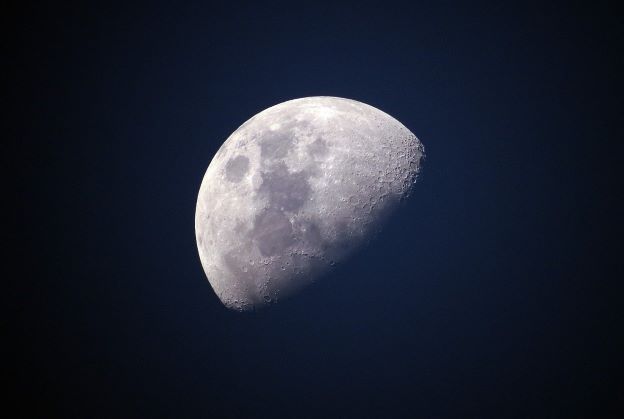Lunar exploration has long been a fascination for mankind and it’s not difficult to see why! With the moon being the prime cause behind the tides and solar eclipses it is mandatory to learn more about it.
The moon is typically the brightest object in the night sky, but it is vital to remember that the Sun is integral to observing the Moon and the solar system in general. On the Moon, the dayside is always illuminated by the Sun. Nevertheless, as the Moon moves around the Earth, the portion that is sunlit can change throughout the month.
The shape of the Moon changes from one night to the next if you look at it for any length of time. It may seem smaller at times. It may also seem bigger at other times. Moon’s shape changes every month, but have you ever wondered why?
Well to answer your question, the moon does not change its shape. The moon only appears so because of the lunar cycle and different phases of the moon during this cycle. The lunar cycle during which the moon has 8 phases goes from a new moon to a full moon.
Different Phases Of Moon
There are 8 phases of the moon depending on its location to the sun. When its position varies according to the sun you experience a different shape and that gives an apparent illusion that the moon changes its shape, and that’s not TRUE!
Over the course of a month, you can easily observe different shapes of the moon. Along this journey you see a moon go from a new moon to a full moon and eventually, it disappears completely. And a little bit each night, the moon appears again, and by the next day, it is full once more. Why is this happening?
To understand properly, go through the below mentioned points
- Observed from Earth, phases of the moon describe how, over the course of a month, different parts of its surface are lit up.
- Moonlight, in fact, is simply sunlight, not moonlight at all! There is no light coming from the moon on its own.
- From the surface of the Moon, we receive reflections of the Sun’s light.
- Each night, the amount of the moon’s surface that we can see changes slightly due to the positions of the Earth, Moon, and Sun during the month.
The 8 Phases of the moon are:
- New Moon
- Waxing Crescent
- First Quarter
- Waxing Gibbous
- Full Moon
- Waning Gibbous
- Last Quarter
- Waning Crescent
Before going into details about the different phases of the moon, you need to understand two basic terminologies of waxing and waning.
- The waxing moon is the lunar phase, starting when the moon is just passed its darkest, and continues until the moon is at its brightest
- After the full moon, we experience a waning moon that lasts until we have a new moon again.
- Waxing and Waning can be understood by the shadow that appears on the moon’s surface. If the shadow is on the right then it’s a waning phase and if it’s on the left then its waxing phase.
Now that you understand what waning and waxing is let us discuss about the phases of the moon
New Moon
During this first phase, the Moon is not visible from the Earth and this is the starting point of the lunar cycle. During this phase, the Earth, Sun, and the Moon are in a straight line. Also, a total eclipse of the Sun by the Moon is occasionally possible if the alignment of the Sun, Moon, and Earth is just right.
Waxing Crescent
In the second phase, the moon is slightly visible and is known as ‘waning crescent. During this phase the moon is visible in the form of a thin crescent. While most of this phase is dominated by the bright reflections of Earth from the surface of the Moon, the rest of the Moon is sometimes visible as well. Also, the crescent will grow larger and larger every day until the first quarter phase.
First Quarter
This is the third phase of the moon in the lunar cycle. During this phase, a bright light appears on the right half of the Moon and a dark one appears on the left. Due to the Sun’s light, half of the disc of the moon is visible from Earth all the time. This is why it’s called the ‘first quarter’. This phase appears almost after a week of the new moon.
Waxing Gibbous
This phase comes after the first quarter. By contrast, gibbous refers to a shape that is larger than a semicircle but smaller than the shape taken by the Moon in the First Quarter. During this phase over half of the Moon’s sunlit side is visible, which is perfectly fitting for this phase of the Moon.
Full Moon
After the new moon, when the moon is waxing we reach the ‘full moon’ approximately two weeks after the new moon. On Earth, the daylight side of the Moon is clearly visible. This is the Moon at its most striking. It is only in this phase that complete eclipses of the moon are possible.
Waning Gibbous
Now it’s time for the moon to start disappearing into the dark and this starts with the Waning Gibbous. Originally, this word was winiano, which meant lessening or diminishing. Hence, the waning gibbous phase was named. The Moon appears to resemble the waxing gibbous, with more than half of its daylight side visible, although as the cycle advances, the luminated portion of the Moon will shrink.
Last Quarter
Often referred to as the Third Quarter. On the left side of the Moon, there appears to be lighting, while on the right side of the Moon, there appears to be darkness. It appears that the illuminated part of the Moon gets smaller and smaller every day between the Full Moon and the Last Quarter Moon. When the cycle starts over at the New Moon, the crop will continue to shrink.
Waning Crescent
This is the last phase of the lunar cycle. It occurs when the moon is the shape of a crescent but as the cycle continues, it becomes smaller and eventually disappears. It is also called an ‘old moon’, which is because it appears like a very thin line before it disappears and reemerges as a new moon.
Conclusion
Try paying attention to the enchanting night sky the next time you are out at night. You will be able to observe all these phases of the moon. We finally can conclude now that the moon does not change shape. What does change is the proportion of moon we are able to see from Earth.
You May Like This Article:
 Being Human
Being Human





